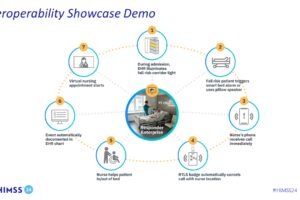There are so many good ideas in healthcare, but tragically so little time, resources, people, and money. Because of our limitations, not every project immediately gets invested in and there are also lots of projects that had their investments slowly run dry until they disappeared entirely. The true tragedy of all of this is that even though we don’t have the resources to effectively do what we need to, these projects cannot move forward without investments and often get left behind, all the while new projects keep on coming.
In order to help bring attention to some areas in healthcare that are currently being overlooked in terms of investments – we reached out to our incredible Healthcare IT Today Community at the CHIME23 Fall Forum for their insights on what areas need more investment. The video below is a compilation of their answers.
Steve Cagle, CEO at Clearwater – It depends. It depends on everybody’s organization and their own risk. An area that we think does not have enough investment right now is in that process. It’s in that process of really identifying where you have the most critical risks in the organization and where you need to invest those limited resources. There’s a huge problem in healthcare – we don’t have enough resources, we don’t have enough people, we don’t have enough money. So as a CIO, I need to be very very diligent about where I’m making those investments. The best way to do that is through a very comprehensive, rigorous, and ongoing risk analysis so you know where your current risks are and you’re applying those resources in the areas that are going to make the most difference.
Clint Drawdy, CEO at iMethods – We need to continue to invest in our people. I find that under stress, all of our leaders are really good at execution (we spent a lot of time on it) and good at budgets right now, but strategy and people sometimes get off our agenda. So I would say let’s invest more time, energy, and effort back to people, and culture, and then strategy will solve the problems of technology and execution if we keep the right priority in mind.
Jason Griffin, Head of Digital Health Strategy at Nordic – Always cyber. It feels like you’re spending too much when there’s no activity – until there’s an incident, then you feel like you haven’t spent enough. There are so many organizations today that still have not reached just the basic level of maturity around their cybersecurity program and with that comes investment and education. Not just investment in technology but investment in people and gaining more knowledge around the threat landscape that we see today in healthcare. That landscape is growing by the day – by the hour every day in terms of new opportunities for hackers to come into our systems. So the more that we can invest into that and the more we can identify really zero-day type threat mitigation, immediate mitigation – the investment is going to go so far in terms of protecting our organization and protecting our patients.
Jeff Fuller, VP of Data Analytics at Divurgent – Everybody’s talking about AI, but I really do think other industries have shown that there’s a lot of administrative waste that can be solved with the way AI is today. So it’s not something to be afraid of, I think just doing standard process improvement, looking for gaps in processes that can be eliminated or reduced and the number of steps it takes to do (which is some simple modeling) is a great way to start. A lot of times it takes some tech talent, so finding a way to start small is a good way to get organizations to adopt it more quickly.
Sean Kelly, Chief Medical Officer at Imprivata – Investment in good mobile technology, both to make it more secure but also more usable, efficient, and productive for us. There’s good technology now, both BYOD technology but also for shared mobile enterprise technology. Digital identity is the key to that but I think mobile is a big area of investment in our private lives and consumer lives. We’re using it more and more, and in healthcare I think we want to do the same – to chart at the bedside and provide better care, it just has to be secure and efficient.
Aditya Bansod, Co-Founder and CTO at Luma Health – I think healthcare needs more investment in how the consumer experiences healthcare, and that doesn’t just mean the technology platforms and the IT solutions, but things around like the physical footprint of a location, like status boards outside of urgent cares, being able to wait in virtual lines for the experience, being able to get a QR code to check-in. All the different parts along those touchpoints a patient has around – going from the moment they want care to actually being in front of a physician (whether it’s virtual or physical). We have underinvested in that area and so I think as we look to apply capital dollars, they are most definitely in the IT universe, but they’re also in the physical footprint, the virtual footprint, and all the other touch points that a patient goes through when they’re connecting to that care experience.
Robbie Hughes, CEO at Lumeon – I think we’ve seen a lot of effort put into making sure that the decisions made by clinicians are the right decisions. A lot of effort and supporting those guys, but how are you delivering that across a team? How are we making sure that you’ve got the operational process to support those decisions? If you make a really good clinical decision but then you fail to execute it reliably and scalably – is that really the right clinical decision? Could there have been a better decision that you could have executed well and then measured off the back of it? We can see this endemically everywhere in healthcare but I think it’s an area that is underappreciated and needs to get investment that is solely lacking today
Lena Kannappan, Co-Founder at Healthcare Triangle – Cybersecurity has been not top of the list of board-level discussion or top-level objectives. With the recent ransomware attacks, it is in my view that cybersecurity should be one of the top two initiatives within health systems. The hospital should invest in tools, technologies, and processes so that they’re prepared to face these cyber-attacks and safeguard patient lives and as well as patient safety.
Huge thank you to Steve Cagle, CEO at Clearwater, Clint Drawdy, CEO at iMethods, Jason Griffin, Head of Digital Health Strategy at Nordic, Jeff Fuller, VP of Data Analytics at Divurgent, Sean Kelly, Chief Medical Officer at Imprivata, Aditya Bansod, Co-Founder and CTO at Luma Health, Robbie Hughes, CEO at Lumeon, and Lena Kannappan, Co-Founder at Healthcare Triangle for taking the time out of you day to come and speak with us! And thank you to all of you for taking the time to read this article and watch this video! We could not do this without your support. What areas of healthcare do you think needs more investment and why? Let us know in the comments down below or over on social media. We would love to hear from all of you!













